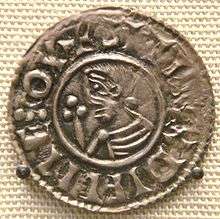Ímar ua Ímair
Ímar ua Ímair (Old Norse: Ívarr, died 904) was a Norse or Norse-Gaelic King of Dublin. He was a grandson of Ímar and a member of the Uí Ímair.[nb 1]
| Ímar ua Ímair | |
|---|---|
| King of Dublin | |
| Died | 904 Strathearn |
| Dynasty | Uí Ímair |
Biography
Ímar ua Ímair became King of Dublin sometime prior to 902, but probably not before 896 when his uncle (or father) Sitriuc mac Ímair died.[1] In the decades preceding his reign, Dublin was wracked by internal strife and dynastic feuds, greatly weakening the kingdom. The neighbouring native Irish kings sought to take advantage of this to increase their own influence. An additional motivating factor may have been revenge for Viking raids on Irish religious sites – in 890-91 alone the Norsemen plundered Irish monasteries at Ardbraccan, Clonard, Donaghpatrick, Dulane, Glendalough and Kildare.[2]
In 902 the kingdoms of Brega and Leinster formed an alliance and drove the Vikings from Dublin.[3] The exiled Dubliners, led by Ímar ua Ímair, retreated to territory in Scotland over which they exerted some control.[2] The following year they were engaged in warfare with Constantine, King of the Picts, raiding Dunkeld.[nb 2] A victory was won by Constantine the following year at a place identified by the Chronicle of the Kings of Alba as Strath Erenn.[5][6] Ímar ua Ímair is mentioned in the Annals of Ulster in the same year for the first and only time. This sole entry details his death at the hands of the Picts of Fortriu – this is identified as the same battle as that mentioned in the Chronicle.[7][8]
The Vikings did not return to Dublin until 917, when Sihtric, another grandson of Ímar, landed forces in Ireland and inflicted a decisive defeat on the armies of Leinster.[9]
Family
There is some question as to whether the identifier "ua Ímair" refers to a literal grandson of Ímar, and it has been suggested it simply refers to a descendant, or even an individual of unknown descent. However, the fact "ua Ímair" is not seen in the Irish annals after 948 suggests it was solely used for literal grandsons.[10]
Ímar had at least three sons, Bárid (d. 881), Sichfrith (d. 888), and Sitriuc (d. 896), all three of whom were kings of Dublin. Which of these sons, if any, was Ímar ua Ímair's father is not known. Other grandsons of Ímar have been identified as Ragnall, Sihtric Cáech, Amlaíb, and Gofraid, most of whom were kings in their own right.[1]
Notes
- To avoid confusion the subject of this article is identified as Ímar ua Ímair throughout, and his grandfather simply as Ímar.
- Constantine is known as both King of the Picts and King of Alba, with his predecessors favouring the former title and his successors the latter.[4]
References
Citations
- Downham pp. 28–29
- Brink and Price p. 431
- Sawyer p. 92
- Woolf pp. 93–117
- Woolf pp. 122–126
- Skene p. cxl
- Annals of Ulster s.a. 904.
- Downham p. 261
- Downham pp. 31–32
- Downham p. 5
Bibliography
- "The Annals of Ulster". Corpus of Electronic Texts (15 August 2012 ed.). University College Cork. 2012. Retrieved 23 November 2014.
- Brink, Stefan; Price, Neil (31 October 2008). The Viking World. Routledge. ISBN 978-1-134-31826-1.
- Downham, Clare (2007). Viking Kings of Britain and Ireland: The Dynasty of Ívarr to A.D. 1014. Edinburgh: Dunedin Academic Press. ISBN 978-1-903765-89-0.
- Sawyer, Peter (January 2001). The Oxford Illustrated History of the Vikings. Oxford University Press. ISBN 978-0-19-285434-6.
- Skene, William Forbes (1867). Chronicles of the Picts, Chronicles of the Scots: And Other Early Memorials of Scottish History. H. M. General Register House.
- Woolf, Alex (2007). From Pictland to Alba: 789 – 1070. Edinburgh University Press. ISBN 978-0-7486-1234-5.
External links
- CELT: Corpus of Electronic Texts at University College Cork. The Corpus of Electronic Texts includes the Annals of Ulster and the Four Masters, the Chronicon Scotorum and the Book of Leinster as well as Genealogies, and various Saints' Lives. Most are translated into English, or translations are in progress.
